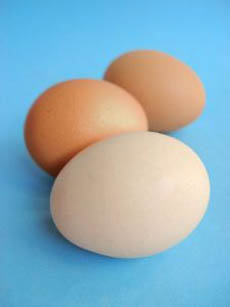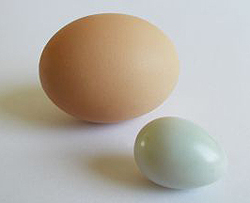

Brown eggs come from brown hen varieties, white eggs from white hens. Photo by Alessandro Paiva| SXC.
January 2008
Last updated March 2010
|
 |
All About Eggs
Page 2: Egg Facts & Tips
This is Page 2 of a two-page article. Click on the black links below to visit other pages.
Egg Facts
Is there a nutritional difference between brown eggs and white eggs?
No, they have the same nutritional value. The shell color is a function of the color of the hen: White breeds produce white eggs and brown breeds produce brown eggs (simple!). The reason that brown eggs tend to be costlier is that brown breeds are larger and require more feed. The color of the yolk is based on the feed. A diet of wheat and white corn meal would produce an almost colorless yolk; but adding yellow corn meal and/or marigolds produces the deep yellow yolk preferred in the U.S. |
|

Photo by Monika Szczygiet | SXC. |
How long are eggs fresh after purchase?
Eggs can be stored in their cartons in the refrigerator for four to five weeks beyond the carton’s date. If the date is stamped in Julian numbers, which reflects the consecutive days of the year, note that January 1 is 001 and December 31 is 365. Once an egg begins to age, it loses moisture through its shell, which is porous, and begins to dry out. The membranes that hold the egg structure begin to loosen; that’s why the yolk may not be anchored in the center of the white. An older egg would be most appropriate for a mixed dish, a batter or a hard cooked egg, which should be easier to peel than a freshly laid egg.
What’s the best way to store eggs?
Eggs should be refrigerated at 40°F. THe USDA advises that eggs left out for more than two hours may be subject to bacteria growth, and should be discarded. (It is fine to let raw eggs come to room temperature before using—20 to 30 minutes. But they should be used and cooked or re-refrigerated within two hours.) Leave the eggs in their carton on an inside refrigerator shelf where temperature does not vary—not on the refrigerator door. The carton insulates the eggs from loss of moisture.
What’s the story about salmonella in eggs?
In the 1980s, a specific strain of salmonella bacteria was found growing in the reproductive organs of egg-laying hens. It is rare, but in one in 20,000 eggs, the Salmonella bacteria may infect an egg. Cooking destroys the bacteria, which is why people are advised not to use raw eggs in egg nog, steak tartare, Caesar salad, etc. To use “safe raw eggs” in recipes, the USDA recommends heating the eggs in a liquid from the recipe over low heat, stirring constantly, until the mixture reaches 160°F. Then combine it with the other ingredients and complete the recipe.
|
|
 Photo of eggs by Rodolfo Clix | SXC.
Photo of eggs by Rodolfo Clix | SXC. |
Egg Tips
Never use a cracked raw egg. It can easily be contaminated with bacteria.
Tell a raw egg from a boiled egg by spinning it on the countertop. The cooked egg will spin easily while the raw egg will wobble due to its shifting liquid content.
Look at the egg shell to determine an egg’s freshness. An old egg has a smooth and somewhat shiny shell; a fresh egg has a rough, matte shell.
If you have more eggs than you can use, you can freeze them. However, they must be removed from the shell. Whites will freeze well for 12 months. Yolks don’t freeze well, so you may also wish to separate the yolks from whites.
Information courtesy of the American Egg Board and the USDA.
Go To The Article Index Above
<
|






